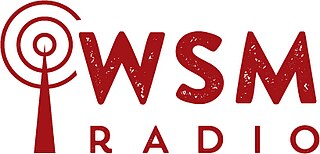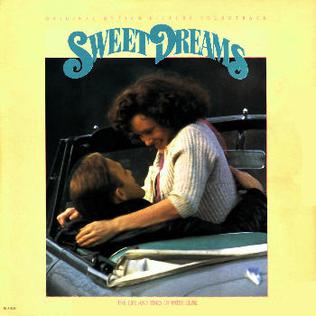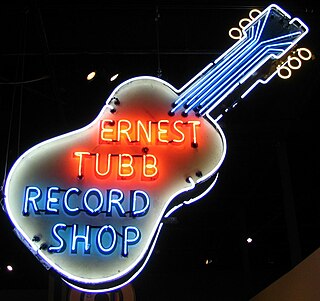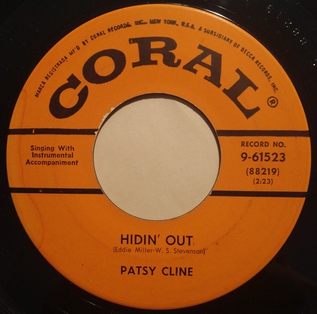Related Research Articles

Ernest Dale Tubb, nicknamed the Texas Troubadour, was an American singer and songwriter and one of the pioneers of country music. His biggest career hit song, "Walking the Floor Over You" (1941), marked the rise of the honky tonk style of music.

WSM is a commercial AM radio station, located in Nashville, Tennessee. It broadcasts a country music format and is known as the home of the Grand Ole Opry, the world's longest running radio program. The station is owned Ryman Hospitality Properties, Inc. After nearly 40 years broadcasting from a studio within the Gaylord Opryland Resort & Convention Center, WSM currently operates out of a temporary studio at its parent company's offices. A new, permanent studio inside the former home of Roy Acuff, just outside the Grand Ole Opry House, is set to open in July 2024.

Aubrey Wilson Mullican, known professionally as Moon Mullican and nicknamed "King of the Hillbilly Piano Players", was an American country and western singer, songwriter, and pianist. He was associated with the hillbilly boogie style which influenced rockabilly. Jerry Lee Lewis cited him as a major influence on his own singing and piano playing.
"Half as Much" is an American pop standard song written by Curley Williams in 1951. It was recorded by country music singer Hank Williams in 1952 and reached number two on the Billboard Country Singles chart.
"Cold, Cold Heart" is a country music and pop song written and first recorded by Hank Williams. This blues ballad is both a classic of honky-tonk and an entry in the Great American Songbook.

RCA Studio B was a music recording studio in Nashville, Tennessee established in 1957 by Steve Sholes and Chet Atkins for RCA Victor. Originally known simply as the RCA Victor Studio, in 1965 the studio was designated as Studio B after RCA Victor built the newer, larger Studio A in an adjacent building.
William Owen Bradley was an American musician, bandleader and record producer who, along with Chet Atkins, Bob Ferguson, Bill Porter, and Don Law, was a chief architect of the 1950s and 60s Nashville sound in country music and rockabilly.

Dreaming My Dreams is the twenty-second studio album by American country music artist Waylon Jennings. The album was co-produced with Jack Clement and recorded at Glaser Sound Studios in Nashville, Tennessee, between February and July 1974.
Paul Cohen was an American country music producer.

Sweet Dreams is the 1985 soundtrack album to the movie of the same name, starring Jessica Lange and Ed Harris about the life of country music star, Patsy Cline. The soundtrack is composed entirely of songs previously recorded and released by Patsy Cline.

Hank Williams' discography is composed of 41 singles and 2 ten-inch LPs released during his six-year career; as well as posthumous work including: singles, compilation albums and previously unreleased material. During his lifetime, Williams placed 30 songs on Billboard's Top C&W Records, while he had eleven number one hits.
Zeb Turner was an American country music songwriter and guitarist, and pioneer of rockabilly.

The Midnite Jamboree is a radio program that has aired on WSM in Nashville, Tennessee since May 3, 1947. It was launched by country musician Ernest Tubb. The program was recorded from Ernest Tubb Record Shop in Nashville, Tennessee each Saturday. Through a brokered programming arrangement with Ernest Tubb Record Shop, the Jamboree aired following the Grand Ole Opry; as the program's name implied, it aired at midnight Central Time.
"Honky Tonkin'" is a 1947 country music song, written and recorded by Hank Williams. His song went to #14 on the Billboard country music chart in 1948. In 1982, it became the sixth chart topping single for Williams' son, Hank Williams Jr.
John Beasley Smith was an American composer and big band musician. "That Lucky Old Sun" (1949) one of his better known works, was covered by many well-known artists. He often worked with Haven Gillespie and toured the nation with his group, "Beasley Smith and His Orchestra".

"I'm a Long Gone Daddy" is a country song written and recorded by Hank Williams. It was released in 1948 on MGM Records and became his second top ten hit.
"A Mansion on the Hill" is a song written by Hank Williams and Fred Rose and originally recorded by Williams on MGM Records. It peaked at No. 12 on the Most Played Jukebox Folk Records chart in March 1949.
"Window Shopping" is a song written by Marcel Joseph and popularized by country singer Hank Williams, who released the song in July 1952 on MGM Records. Joseph was a French Jew who settled in New York City in 1914 and grew to love country music, working as an illustrator at the Journal American by day and writing songs in his spare time.
Glenn Snoddy was an engineer and recording studio owner in Nashville, Tennessee. He recorded major Country and Folk artists such as Johnny Cash and Hank Williams.

"Hidin' Out" is a song by American country music singer Patsy Cline. It was composed by Eddie Miller and W.S. Stevenson. It was released as the second single in Cline's career and second issued on Coral Records. It originally appeared on the album, Songs by Patsy Cline.
References
- 1 2 Blevins, Charlene. "Hank Williams – "Lovesick Blues" – Castle Studios – Nashville, Tennessee (1948)". Paste Media Group. Retrieved 21 September 2021.
- ↑ Turpen, Brian. "Hank's Historical Marker in Cincinnati and the Herzog Studio". Hank Williams Books. Retrieved 21 September 2021.
- 1 2 3 4 Kingsbury, Paul (1998). The Encyclopedia of Country Music. New York, New York: Oxford University Press. p. 88. ISBN 978-0-19-517608-7.
- 1 2 3 Cooper, Peter. "History Lesson: Nashville's Music Milestones from the Bradleys to the Outlaws and Beyond". Mix Online. Retrieved 21 September 2021.
- ↑ Murray, Noel. "Pop History: Francis Craig and Nashville's first-ever hit record". Nashvillescene.com. Retrieved 21 September 2021.
- ↑ Snoddy, Glen (1972). "Nashville, The Recording Center" (PDF). Country Music Who's Who. Record World. Retrieved 10 May 2024.
- ↑ Carey, Bill. "A $1,000 loan produces an industry". Nashville Post. Retrieved 21 September 2021.
- ↑ Turpen, Brian. "Hank's Historical Marker in Cincinnati and the Herzog Studio". Hank Williams Books. Retrieved 21 September 2021.
- ↑ "Owen Bradley". Country Music Hall of Fame and Museum. Retrieved 21 September 2021.
- ↑ "Kitty Wells". 1976. Retrieved August 13, 2024.